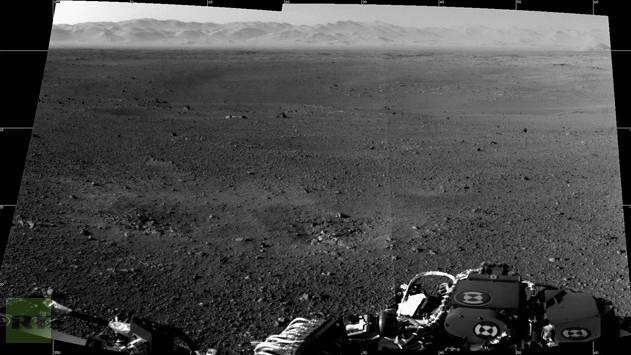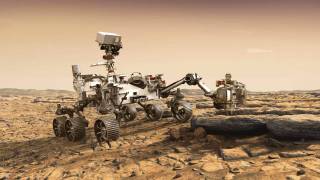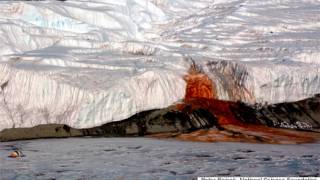Engineers try to explain mysterious image in photo from Mars rover
Source: latimes.com
A photo of Mars taken by Curiosity shows what might be the NASA rover’s spacecraft crash-landing in the distance. If so, it ’would be an insane coincidence,’ one engineer says. Did Curiosity capture the galactic equivalent of the Zapruder film when it landed on Mars?
Seconds after the NASA robot’s landing Sunday night, Curiosity managed to squeeze off a handful of fuzzy, black-and-white photographs. One, taken with a device on its rear known as a Hazcam, captured the pebble-strewn ground beneath the rover and one of its wheels — and a blotch, faint but distinctive, on the horizon.
The images were relayed by a passing satellite. Two hours later, the satellite passed overhead again. This time, Curiosity sent home a new batch of higher-resolution photos. They showed the same horizon.
The blotch was gone.
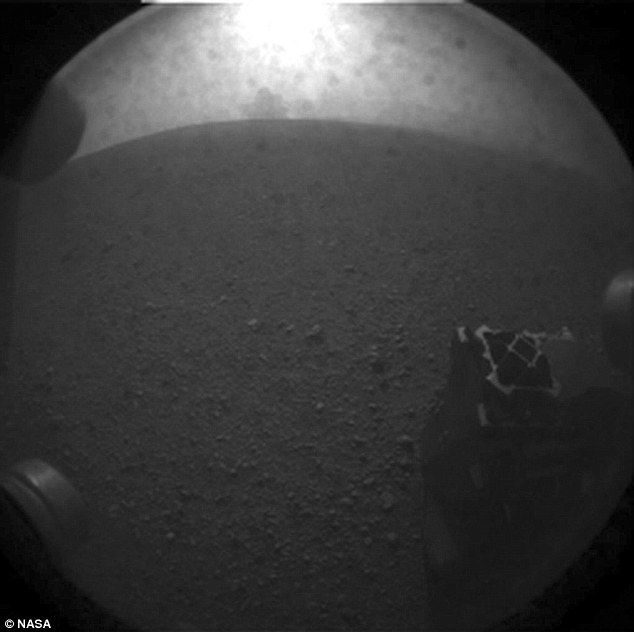
One of the first images taken by NASA’s Curiosity rover: Visible in the centre of the picture on the horizon is an unexplained shape. Original image as provided by NASA.
Space junkies raced onto the Internet with giddy speculation about the difference between the photos.
Curiosity, the largest spacecraft ever sent to another planet, had just sailed through deep space for almost nine months and more than 350 million miles. It landed on its own, meaning scientists had no control over where, exactly, it would wind up, what direction it would be pointed in or when it would snap its first images.
After all of those variables, the space junkies insisted, Curiosity had somehow snapped a photo of its chariot crash-landing a safe distance away, as planned. The camera shutter had been open for 200 milliseconds.
The blotch did look like a billowing plume of some sort, erupting from the horizon. But the image "would be an insane coincidence," one engineer said. Most dismissed the chatter as wild-eyed speculation and a statistical impossibility. It was just dirt on the lens, some said — maybe a dust devil swirling in the distance, but nothing more than that.
Yet a pesky fact remained. In the first photo, the blotch is there. "And then it’s not," said Sarah Milkovich, a scientist at the Jet Propulsion Laboratory in La Cañada Flintridge and a leader of the team responsible for delivering images documenting the mission.
Early Tuesday morning, JPL engineers received a new image of the landing zone, taken by another satellite. With tongue in cheek, this photo was labeled the "crime scene" photo, because it not only showed Curiosity on the ground, but all of the pieces of the spacecraft that the rover had discarded on the way down.
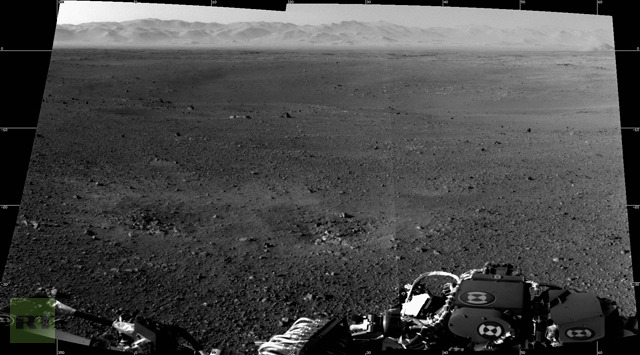
View of the Martian surface made up of two images from the navigation cameras on the mast of NASA’s Curiosity rover in Mars
To the southwest was the supersonic parachute that had taken Curiosity out of free-fall, and was then jettisoned so it wouldn’t land on top of the rover and smother it.
To the southeast was the heat shield, which soared to temperatures as high as 3,800 degrees and was then ditched so that Curiosity could turn on its radar to navigate its landing.
And to the northwest was the spacecraft that had deposited Curiosity on the surface. Known as the "sky crane," it was the remnants of the final stage of the rover’s intricate descent.
Minutes before landing, Curiosity had been contained in an experimental "backpack" that lowered itself to the ground using powerful rocket engines. The engines could have kicked up so much dust that it suffocated the rover. So, just 66 feet above the ground, the backpack spat out Curiosity, leaving the rover dangling by three ropes.
The hovering spacecraft lowered Curiosity to the ground and was then cut loose. Once free, the crane throttled up its engines and arched across the Martian sky.
The crime scene photo showed that the sky crane had crash-landed, as designed, about 2,000 feet away — and in the direction Curiosity’s rear was pointed toward when it snapped the first photo showing the blotch. The new photo also showed that the sky crane, when it crash-landed, kicked up a violent wave of dirt that had scarred the surface of Mars.
The impossible, it seemed, was possible.
"I don’t think you can rule it out," Curiosity mission manager Michael Watkins said Tuesday. "It bears looking into."
Though the coincidence would be of little scientific value, "it would be incredibly cool. ... A crazy, serendipitous thing," Watkins said.
Justin Maki, a JPL engineer and scientist who led the team that developed the Hazcams, shorthand for hazard-avoidance cameras, said further review had suggested that the photograph might not be as crazy as it sounded initially. Between the front and rear Hazcams, the cameras covered 240 degrees of the horizon, or about two-thirds. And the material the sky crane kicked up when it crashed could have hung in the air for a minute or two, he said — Mars’ gravity is 38% as strong as Earth’s — which could have increased the chances of capturing the image.
"Something was out there," he said.
[...]
Read the full article at: latimes.com
Also tune into Red Ice Radio:
George J. Haas & William R. Saunders - The Martian Codex
Andrew D. Basiago - Teleportation Trip to Mars & Life on Mars - Two Parts
Alfred Webre - Mars and Moon Bases, Time Travel, Teleportation, Aliens & Genetic Alteration
Alfred Webre - Exopolitics, NASA Bombing of the Moon, Outer Space Treaty & E.T.
Peter Levenda - Secret Space Program & NASA’s Nazis
Ted Twietmeyer - What NASA isn’t Telling you about Mars
Mike Bara - Dark Mission, The Occult NASA Moon Mission
Richard Dolan - The Secret Space Program & Breakaway Civilization
